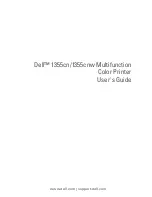
Preparation
19
Note
• When cutting paper after printing, fold the
paper along the perforated line. Then reverse
the fold in the opposite direction and cut the
paper along the folded line.
• If you are printing on the reverse side of a
sheet with a different printer, the ink may take
some time to dry.
Handling of paper and ink cassettes
During printing
• Do not open the ink cassette compartment cover, as print quality may be reduced.
• Do not remove the paper cassette or ink cassette.
• Do not pull the paper while it is moving.
• Be sure to remove printed paper before 10 or more sheets have piled up. Failure to do so
may result in a paper jam. Be particularly sure to remove paper with a high degree of curl
before it piles up.
• Do not touch the print surface with your fingers.
After printing
• Do not remove unused sheets of paper from the paper cassette. Close the cassette lid, then
insert the paper cassette into a plastic bag and store so that it lies flat.
• After removing the paper cassette, close the paper cassette compartment cover to prevent
dust from getting inside the printer.
• Remove the ink cassette and store it in a plastic bag or other safe container.
Handling printed paper
• Pay special attention to the following, otherwise discoloration, fading and color transfer may
occur.
• Do not allow objects such as vinyl desk mats, name card cases, or plastic erasers to come
in contact with the printed surfaces. When storing printed paper in an album, select holder
sleeves made of nylon, polypropylene or cellophane.
• Do not allow any volatile solvents such as alcohol to come in contact with the printed
surface.
• Do not touch the printed surface.
• Do not leave printed surfaces in contact with one another, or place any other papers on
printed surfaces for a certain period of time.
• Do not store printed paper in locations subject to high temperature, high humidity, or direct
sunlight.
• When writing on a printed surface, use permanent markers (oil-based) only. You may use
permanent markers (oil-based), water-based markers, pencils and oil-based ball point pens
to write on the back of printed papers.
• You can use printed images for your personal enjoyment. Copyright laws prevent their use in
any other way without the written permission of the copyright holders.
• Do not reuse paper that has already been printed on.
Summary of Contents for KX-PX10MWKIT
Page 110: ...110 Notes ...
Page 111: ...111 Notes ...
















































